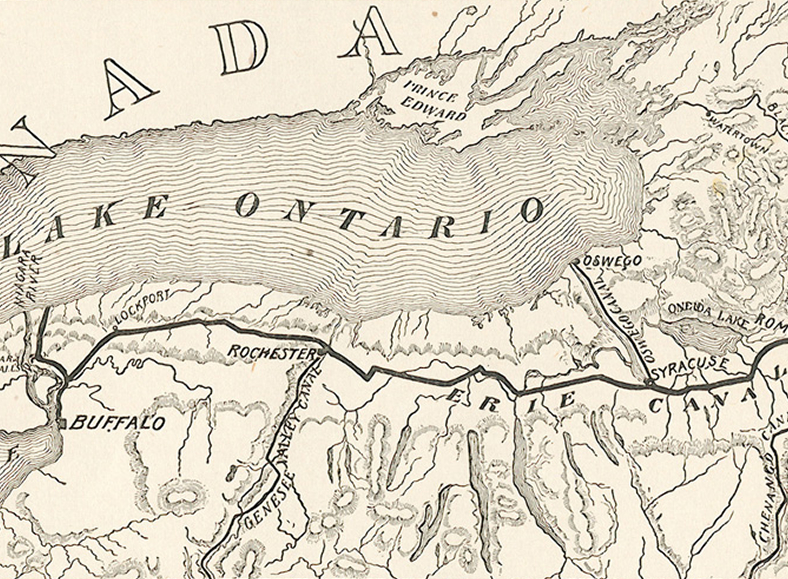Overview of the Erie Canal.
A landmark achievement in US history, the Erie Canal spans 363 miles from Albany to Buffalo. Completed in 1825, it revolutionized 19th-century trade and transportation by making shipping faster and more affordable. It played a vital role in shaping New York State’s economy and infrastructure while leaving a complex legacy of industrial growth, environmental change, and the displacement of Indigenous Peoples.

Impact on Indigenous Peoples.

The 1797 Treaty of Big reduced Haudenosaunee homelands to small reservations | Credit: Image courtesy of The Buffalo History Museum

A sacred burial ground and historic site in South Buffalo honoring Indigenous heritage, history, and culture | Credit: Photo, 2024
Complex Legacies.
The Erie Canal stands as both an engineering feat and a force of upheaval. While it reshaped transportation and commerce, it also displaced the Haudenosaunee, disrupted their lands, and contributed to a lasting legacy of removal, environmental destruction, and economic hardship. The influx of settlers and industries further eroded Haudenosaunee sovereignty, diminishing their control over their homelands and resources.

Seneca women and children pose at Maplewood Park, Rochester, NY, 1908 | Credit: From Albert R. Stone Negative Collection. Courtesy of the RMSC. Rochester, N.Y.

View of Lake Erie, Fort Erie, and the Buffalo Creek Reservation, 1811 | Credit: Image courtesy of The Buffalo History Museum
Displacement and Hardship.
The Haudenosaunee people faced significant displacement and hardship as a result of the canal's development, as their homelands were altered and forcibly taken. Despite these challenges, they demonstrated resilience working to preserve their culture, traditions, and community ties in the face of profound transformation.

Construction and Engineering.

Map of the route of the Erie Canal | Credit: Scribner's Magazine, 1896

Excavating the Deep Cut in Lockport, N.Y., c. 1825 | Credit: Image courtesy of the Buffalo History Museum
Shaping the Waterway.
Construction of the Erie Canal began on July 4, 1817, in Rome, New York. Thousands of workers carved the 40-foot-wide, 4-foot-deep canal using simple tools. The project included 83 locks to manage elevation changes, making it one of the world’s longest and most ambitious canals at the time.

Locks in Black Rock along the Niagara River | Credit: Image courtesy of The Buffalo History Museum


The “Flight of Five Locks,” Lockport, N.Y., c. 1850 | Credit: Image courtesy of The Buffalo History Museum
An Engineering Marvel.
The Erie Canal’s design revolutionized infrastructure. Its lock system was groundbreaking for the period, enabling boats to navigate New York’s diverse terrain. The engineers’ route ensured a continuous water supply despite three high points along the canal. They used horses, mules, hand tools, and thousands of laborers. They even used machines that they had invented out of necessity. The canal proved to be America's first practical school of engineering.


Economic and Social Impact.

Canal boats on the Erie Canal, Buffalo, N.Y., 1889 | Credit: Image courtesy of The Buffalo History Museum

Erie Beach Pier, Buffalo, N.Y., 1925 | Credit: Image courtesy of The Buffalo History Museum
Economic Growth and Development.
Immense changes followed after the opening of the Erie Canal. Towns and businesses along its banks flourished, creating thriving economies. Large numbers of immigrants soon followed, traveling west in search of opportunity. Ideas and movements like abolition, women's suffrage, and religious revivalism also traveled along its waters.

Women’s Suffrage March, Washington, D.C., 1913 | Credit: Image courtesy of the Library of Congress

Women’s rights advocates Elizabeth Cady Stanton and Susan B. Anthony | Credit: Image courtesy of the Library of Congress, c. 1880-1902
Women’s Suffrage.
The Erie Canal played a significant role in the development and spread of the women’s suffrage movement in the 19th century. The canal served as a crucial transportation artery for social movements and ideas.

First meeting of the Niagara Movement, a Civil Rights organization, 1905 | Credit: Courtesy of the Library of Congress

The Colored Musicians Club, Buffalo, N.Y. | Credit: Image, 2024
Abolition and the Underground Railroad.
The canal and its surrounding areas provided a route for former enslaved people seeking freedom along the Underground Railroad. The Erie Canal corridor was also a hot spot for the abolitionist movement, with activists using the canal to spread their message and organize against slavery.

Palatine Germans in the Mohawk Valley

Dante Place, Canal District, Buffalo, N.Y., 1910 | Credit: Image courtesy of The Buffalo History Museum
The Immigrant Experience.
The Erie Canal was a crucial pathway for 19th-century immigrants. It provided jobs, westward passage, and community building while significantly boosting immigration to New York.

Step into the story.
Visit the Waterway of Change exhibit at Canalside for an interactive experience guiding you through more than 200 years of history.


